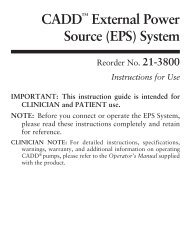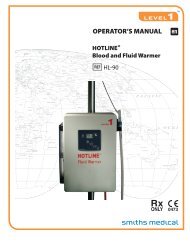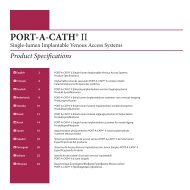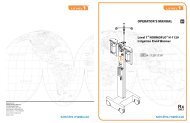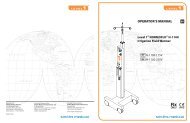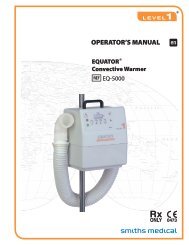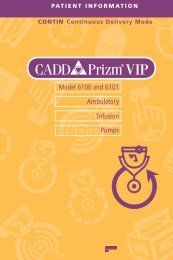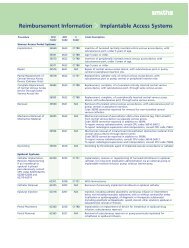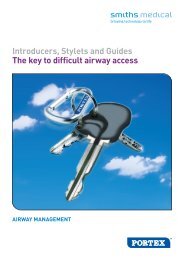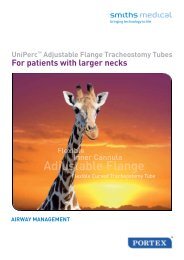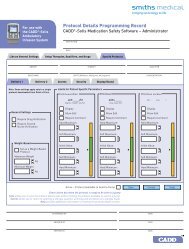40-5091-24B IFU PAC-PACII.indd - Smiths Medical
40-5091-24B IFU PAC-PACII.indd - Smiths Medical
40-5091-24B IFU PAC-PACII.indd - Smiths Medical
You also want an ePaper? Increase the reach of your titles
YUMPU automatically turns print PDFs into web optimized ePapers that Google loves.
English<br />
TABLE OF CONTENTS ....................................................................... PAGE<br />
I. INTRODUCTION .............................................................................. 3<br />
A. Product Description ........................................................................................ 3<br />
B. Indications for Use ........................................................................................... 3<br />
C. Contraindications ............................................................................................ 3<br />
D. Potential Complications .................................................................................. 3<br />
II. WARNINGS ....................................................................................... 4<br />
III. PRE-IMPLANTATION CONSIDERATIONS ........................................ 4<br />
A. Preparation of the System ............................................................................... 5<br />
A.1 Unassembled Systems ............................................................................. 5<br />
A.2 Pre-assembled or Preconnected Systems ............................................. 5<br />
IV. CATHETER PLACEMENT TECHNIQUES ........................................... 5<br />
A. Per cutaneous Puncture – Method A<br />
(Interventional Radiologists) .......................................................................... 5<br />
B. Percutaneous Puncture – Method B (Surgeons) .......................................... 6<br />
C. Surgical Cutdown ............................................................................................. 6<br />
D. Arterial Placement (Arterial systems only) .................................................. 6<br />
V. PORTAL AND SITE PREPARATION ...................................................<br />
7<br />
A. Prepare Subcutaneous Pocket ......................................................................... 7<br />
B. Catheter-Portal Assembly ............................................................................... 7<br />
B.1 ULTRA-LOCK® Connector ...................................................................... 7<br />
B.2 CATH-SHIELD® Connector .................................................................. 7<br />
B.3 WING-LOCK® Connector (Dual-lumen Systems) ............................ 7<br />
C. Flow Check ........................................................................................................ 8<br />
D. Site Closure ....................................................................................................... 8<br />
E. Postoperative Care ........................................................................................... 8<br />
VI. INSTRUCTIONS FOR SYSTEM ACCESS ............................................ 8<br />
A. Determining System Integrity ........................................................................ 8<br />
A.1 System Integrity is Verifi ed – Portal Will Not Be Used<br />
Immediately ............................................................................................ 9<br />
A.2 System Integrity Is Verifi ed – Injection Or Infusion Will Be<br />
Initiated Immediately ............................................................................ 9<br />
B. Flushing Schedule ............................................................................................ 9<br />
C. Blood Sampling Procedure (Venous Systems Only) .................................... 9<br />
D. Discontinuing System Use .............................................................................. 9<br />
E. References ......................................................................................................... 9<br />
FIGURES ................................................................................................ 91<br />
I. INTRODUCTION<br />
PORT-A-CATH® and PORT-A-CATH® II im plant able venous and arterial access<br />
systems are designed to permit repeated access to the vascular system for the parenteral<br />
delivery of medica tions, fl uids, and nutritional solutions and for the sam pling<br />
of venous blood. Th ese devices should be implanted only by clinicians experienced<br />
or trained in the implantation and maintenance of vascular access devices and<br />
knowledgeable of the risks.<br />
Venous systems may be placed in the arm or chest. Arterial systems are indicated for<br />
direct organ perfusion.<br />
Precaution: Patients who engage in occupations, or in physical activities, such as<br />
golfi ng, swimming, or weight lifting, which involve excessive and /or repetitive<br />
upper extremity and/or shoulder or pectoral girdle motion, should be informed<br />
that such activity may increase the possibility of catheter fragmentation due to<br />
compression of the catheter between the clavicle and fi rst rib (catheter pinch-off<br />
syndrome).<br />
Th e fi gures referred to in this manual are found on a fold-out page inside the back<br />
cover. Specifi cations for the portal and catheter are listed in the Product Specifi cations<br />
booklet packaged with the product.<br />
Patient Information and Clinician Information booklets can be obtained by contacting<br />
<strong>Smiths</strong> <strong>Medical</strong> MD, Inc. in the U.S. at 1 800.426.2448 or <strong>Smiths</strong> <strong>Medical</strong> International<br />
Ltd. the EU Authorized Representative at Tel +44 (0)1923 246434.<br />
A. Product Description<br />
PORT-A-CATH® and PORT-A-CATH® II systems are supplied sterile (EtO sterilized)<br />
and non-pyrogenic. All PORT-A-CATH® and PORT-A-CATH® II products are<br />
designed and intended for single-patient use only. A system con sists of a portal with<br />
one or two self-sealing septa and a single- or dual-lumen catheter and is ac cessible<br />
by percutaneous puncture with a non-coring needle. Systems are also available with<br />
introducer sets.<br />
B. Indications for Use<br />
PORT-A-CATH® and PORT-A-CATH® II systems are indicated when patient<br />
therapy requires repeated vascular access for injection or infu sion therapy and/or<br />
venous blood sampling.<br />
C. Contraindications<br />
PORT-A-CATH® and PORT-A-CATH® II systems are contraindicated for patient<br />
therapy whenever:<br />
• Th e presence of infection, bacteremia, or septicemia is known or suspected.<br />
• Th e patient's anatomy will not permit introduction of the catheter into a vessel.<br />
• Th e patient has severe chronic obstructive pulmonary disease (COPD) (chest<br />
placement only).<br />
• Th e patient has undergone past irradiation of the upper chest area (chest placement<br />
only).<br />
• Th e patient is known to have, or is suspected to have, an allergic reaction to materials<br />
contained in the system or has exhibited a prior intolerance to implanted devices.<br />
(System materials are listed in the Product Specifi cations booklet and on the<br />
package label.)<br />
• Substances are used for patient therapy that are incompatible with any of the<br />
system's components. (System materials are listed in the Product Specifi cations<br />
booklet and on the package label.)<br />
Do not use this product if the package has been previously opened or damaged.<br />
D. Potential Complications<br />
Use of the system involves potential risks normally asso ciated with the insertion<br />
or use of any implanted device or in dwelling catheter, including but not limited to<br />
those listed below:<br />
• Air embolism<br />
• Arteriovenous fi stula<br />
• Artery or vein damage/injury<br />
• Brachial plexus injury<br />
• Cardiac arrhythmia<br />
• Cardiac puncture<br />
• Cardiac tamponade<br />
• Catheter disconnection, fragmentation, fracture, or shearing with possible<br />
embolization of the catheter 1,2,3,4,5,6,7,8<br />
• Catheter occlusion<br />
• Catheter rupture<br />
• Drug extravasation<br />
3



